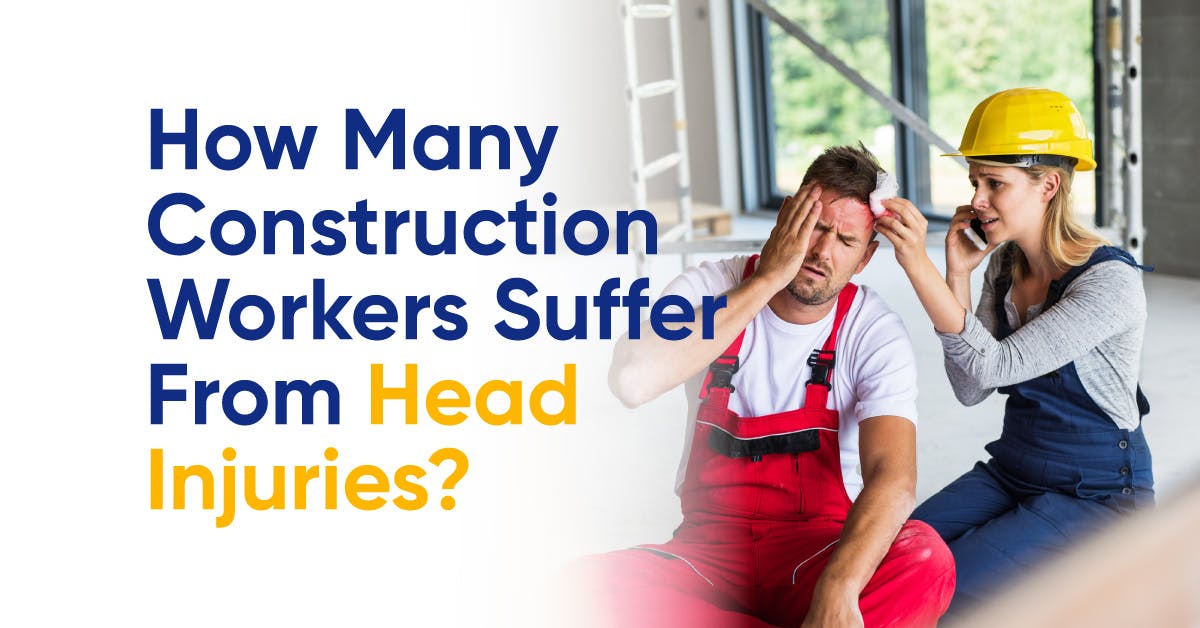Construction sites are dynamic, high-risk environments where head injuries are a significant concern. Head injuries can result from falling objects, tripping, or other similar accidents. Their consequences can range from mild concussions to severe traumatic brain injuries. To mitigate these risks, construction workers rely on helmets designed specifically to prevent head injuries.
Understanding the most common causes of head injuries is crucial for prevention and early intervention. So, before exploring this topic any further, it is important to look at the statistics realted to construction head injuries.
- 800 construction workers suffered from head injuries in 2018, 230 workers died as a result of these injuries
- 2,210 construction workers lost their lives as a result of a traumatic brain injury between 2003 and 2010 (2.6 per 100,000 full-time equivalent workers).
- Traumatic Brain Injuries (TBI) makes up 11–22% of all injuries to the head, and in severe cases, up to 61%.
5 Common Causes of Head Injuries in Construction
In United States, around 10% of Traumatic Brain Injuries are work-related. Unfortunately, construction workers face the constant threat of head injuries. These are the five reasons why these injuries occur so frequently.
1. Fall From Height
Falls from heights are one of the leading causes of traumatic brain injuries in the construction industry. Workers are often required to work on scaffolding, ladders, roofs, and other elevated structures. When a fall occurs, the impact on the head can result in severe head trauma.
2. Slips, Trips, Falls
Slips, trips, and falls are common occurrences on construction sites, often due to uneven surfaces, cluttered work areas, and adverse weather conditions. When a worker falls and hits their head, it can lead to traumatic brain injuries.
3. Electrical Accidents
Electrical accidents can lead to severe electrical burns and, in some cases, traumatic brain injuries when a worker is electrocuted. Electrical incidents may occur when workers come into contact with live wires, faulty equipment, or improperly insulated electrical systems.
4. Vehicle Collisions
Construction sites are often bustling with various vehicles and heavy equipment. Vehicle collisions, whether involving construction vehicles or commercial vehicles, can result in traumatic brain injuries when a worker is struck by a moving vehicle.
5. Falling Objects
Falling objects, whether tools, construction materials, or debris, are a significant hazard on construction sites. When these objects drop from an elevated position, they can strike workers' heads, leading to traumatic brain injuries.
How Helmets Prevent Head Injuries?
Construction helmets are indispensable tools for preventing head injuries in one of the most high-risk work environments. Their design, materials, and compliance with safety standards make them highly effective at reducing the risk of skull fractures, traumatic brain injuries, and other head injuries.
The role of construction helmets in ensuring worker safety cannot be overstated, and their use should be enforced rigorously on construction sites. By prioritizing helmet use, employers and employees alike contribute to a safer and healthier work environment in the construction industry, ultimately saving lives and reducing the long-term impact of head injuries.
1. Impact Distribution
One of the primary ways construction helmets prevent head injuries is by distributing the force of an impact across the helmet's hard shell. This dispersion reduces the localized impact on the skull, decreasing the risk of skull fractures.
2. Energy Absorption
Construction helmets are designed to absorb and dissipate energy upon impact. The suspension system inside the helmet plays a critical role in this process, helping to protect the wearer's head and brain from the full force of a blow.
3. Preventing Skull Fractures
Construction helmets provide a protective barrier against skull fractures. The hard shell serves as a barrier to external objects, while the suspension system inside absorbs and distributes impact forces.
4. Mitigating Brain Trauma
By reducing the risk of skull fractures, construction helmets also mitigate the potential for traumatic brain injuries. Even minor head injuries can have severe consequences, making helmet use crucial.
5. Preventing Falling Object Injuries
Construction sites are often characterized by overhead work, making falling objects a significant risk. Construction helmets with a hard shell provide protection against these objects, reducing the risk of head injuries.
Conclusion
Head injuries are a significant concern in the construction industry due to the nature of the work and the potential hazards involved. Preventative measures, such as the use of personal protective equipment, OSHA safety training, and improved regulations, are essential to reduce the incidence of head injuries among construction workers.
To have a more accurate and up-to-date understanding of the prevalence of head injuries in the construction industry, it is important to enroll in OSHA courses to learn more about the safety and effective use of helmets to reduce head injuries.
Sources:
CDC, CPWR, Science Direct, NCBI


